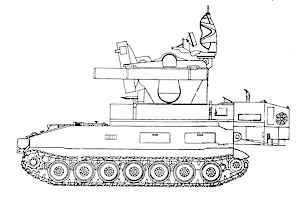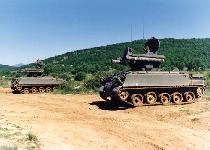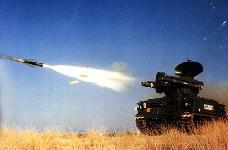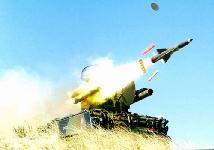



Roland
The ROLAND 2 weapon system is intended for anti-aircraft defence of armoured and mechanized the units to counter aircraft flying to nearly Mach 1.5 and hovering helicopters. ROLAND is generally employed either in complement of the coverage of HAWK defense of zones and corridors not defended by the HAWK, or in prolongation of the HAWK front. ROLAND ensures the overall defense of a zone of 100 km2 vis-a-vis a threat consisted by a patrol of 4 planes or 2 patrols acting at more than 20 second intervals. Deployed on a tracked vehicle derived from the tank AMX 30, it comprises a radar with a range of 16 km, a sighting tube with an infra-red locator that measures the difference between the missile in flight and the line of sight of the fire control radar, and a computer antenna for remote control
Two arm-beams for launching carry each one a missile in its launching tube, and two ammunition stores for munitions each contain one 4 shot mechanism forautomatic unloading of the arm-beam. The crew of the vehicle consists of three man.
Three operating modes are available in the ROLAND 2: the optical mode; the mode radar; and the optical mode recopy-radar or radar-recopy-optics. Whatever operating mode is chosen, the target is detected by the radar, search in site and the continuation of the target after acquisition is carried out manually in radar mode. In the third mode, one of the means of continuation is controlled to the different one, which facilitates their communication.
After the firing, the optics or the radar remain pointed at the target, the computer generates the commands for guidance by using two different groups of measurements: starting from the measurement angular velocities of pointing and programmed values of the distance precise alignment is obtained while adding to the result preceding the commands necessary to the correction by the real variations of the missile compared to the axis of aiming measured by the infra-red goniometer (optical mode), or compared to the direction of the target the commands are transmitted to the missile by the transmitter of remote control.
The missile is ready with the shooting inside its container (tactical packing), itself placed under the arms launchers of the tank. The vehicle has two missiles ready for firing and eight in the trunks.
The American ROLAND program was canceled in September 1981. Previously, low-rate production (LRP) had been approved in FY 79 and FY 80. The initial LRP contracts were let in October 1979, with planned procurement based upon the eventual production of fire units and missiles to support a four-battalion force structure concept. Subsequent budget decisions by President Carter reduced quantities at first to a two-battalion force, then to one battalion. The DOD budget approved by President Reagan in March 1981 originally redirected the program back to four battalions, until it was decided to terminate this effort.
Specifications
|
 |
| Surface to Air (SAM) |
Roland II |
| Range |
maximum: 6 000 m
minimal: 700 to 2 000 m according to the Ceiling |
| Altitude, (m) |
5,500 |
| Basic load on vehicle |
10 missiles
(2 per launcher) |
| Detection range, km |
16.5 |
| Reaction time, sec |
4-10 |
| Firing time, sec |
1st shooting: 8 to 10 seconds
later shooting: 2 to 6 seconds
|
| Speed |
Mach 1.6 |
| Reload time |
approximately 10 second |
|
Probability of hit |
80% |
| Warhead |
HE hollow charge |
| Command guidance |
RF SACLOS or CLOS |
| Radar(s) |
Siemens/Thomson-CSF D-band
pulse-Doppler search radar,
Thomson-CSF J-Band monopulse Doppler tracking radar |
| Emplace/displace time (min) |
3 |
| Support vehicles |
None |
| Chassis |
AMX-30 , Marder APC, trucks,
or in fixed shelters |
|



http://www.fas.org/man/dod-101/sys/land/row/roland.htm
Maintained by Robert Sherman
Originally created by John Pike
Updated Friday, April 14, 2000 3:18:25 PM








